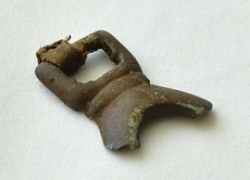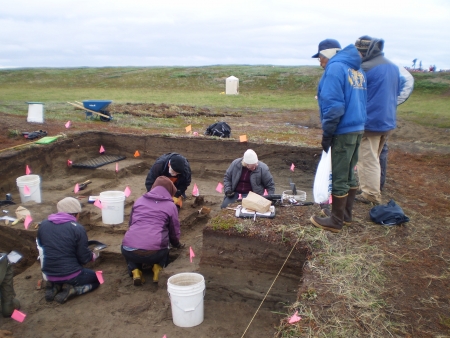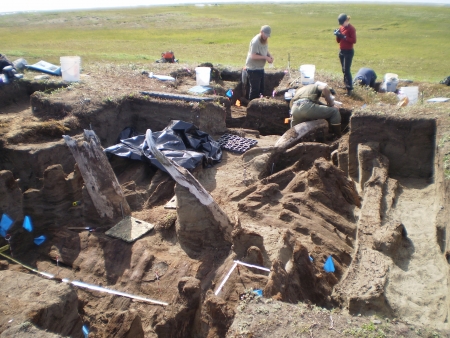Researchers working at Cape Espenberg, Alaska recently recovered cast metal objects apparently derived from eastern Asia. These objects, the first such items to be recovered in a prehistoric Alaskan context, were recovered during summer of 2011, which was the third and final field season of the NSF-funded project led by John F. Hoffecker, principal investigator, and Owen K. Mason, co-principal investigator, of the University of Colorado at Boulder's Institute of Arctic and Alpine Research (INSTAAR). Metallurgical analysis, completed in late 2012 by Harold Kory Cooper at Purdue University, indicates that the artifacts were cast of a lead, tin, and copper alloy suggesting that such metals were arriving in Alaska via trade across the Bering Strait in the late prehistoric period.

Cape Espenberg is located in northwest Alaska on the Arctic Circle at the northernmost point of the Seward Peninsula and the southern entrance to Kotzebue Sound. The cape is comprised of a series of sandy beach ridges, many of them capped with dune complexes that formed over the past 4,500 years. Native Alaskan peoples occupied these ridges throughout this time-span, subsisting on seal, caribou, fish, and other local resources, and often constructing dwellings in the dunes or beach ridges. The focus of the 2009-2011 NSF project was the last thousand years of settlement, beginning with the earliest Inupiat occupation on the sixth youngest ridge, in the context of changing climate conditions.
During the 28 June - 8 August 2011 field season, three house features were excavated at Cape Espenberg: one on the sixth ridge, and two on the large fifth ridge complex. Other house features were excavated on the sixth, fifth, and fourth ridges during the 2009-2010 field seasons. Data pertaining to the geomorphology of the ridges and past climate conditions were collected during each field season.
The cast metal artifacts, a tube-shaped bead and buckle, were recovered from the oldest house feature investigated in 2011. This site is located on the sixth ridge and appears to be roughly one thousand years in age (see Figure 1). The research team opened a total of 50 square meters across this feature and excavated to depths between 50 centimeter and over 1 meter. The stratigraphy indicates that the structure was cut into underlying eolian (wind blown) or beach deposits, preserved at the south and west margins, and subsequently in-filled with wind-deposited sand. Several hearth (or midden) features lie within upper silt-rich beds and may relate to, or even post date, later phases of the house occupation. A total of 3,704 artifacts, including two cast metal objects, and 15,726 faunal remains were recovered from this site.
Hoffecker and Mason subsequently sent several artifacts, including the cast objects, to Cooper for metallurgical analysis. In November 2012 Cooper reported that the compositions of the cast artifacts, are alloys containing large amounts of lead (58-69 percent by weight), tin (17-21 percent by weight), and copper (4-16 percent by weight). These artifacts have so little copper relative to tin and lead they are more accurately referred to as "white metal" than copper alloys. "White metal" is a colloquial term for any metal consisting largely of lead or tin but usually containing other metals such as copper, zinc, and silver. Such alloys are good to work with in casting (i.e., pouring melted metal into a mold) and would have been used to produce decorative objects that would appear similar to silver. Though native copper and meteoritic iron, (i.e. naturally occurring pure metals), were hammered into a variety objects by late prehistoric inhabitants of arctic and subarctic North America, there is no evidence for the smelting, casting, or alloying of metals in the Western Hemisphere north of Mexico prior to the arrival of Europeans. As a result, these two artifacts give the best and least ambiguous evidence to date that non-ferrous industrial smelted metals were arriving in Alaska via prehistoric trade across the Bering Strait.
New excavations at Cape Espenberg in 2011 were on the fifth ridge complex, previously investigated in 1988 by the National Park Service and during the first season of the NSF project (in 2009). Once fully exposed in 2011, the house (Feature 87) provided an unusually well preserved example of early Alaskan architecture (see Figure 2). The main room measured 3.0-3.3 by 2.5-3.0 meters. The rear and side walls were still standing, with some wall members extending almost 1 meter in height. Wall members were split logs that were cut with an adze on the interior surfaces. At the rear, a raised platform was composed of six broad wood boards, formed of logs split in half with the flat face up. Narrower benches composed of only one or two planks ran along the east and west side walls. The floor was also composed of halved, split logs running from front to back of the house, with an open, burnt floor area on the west side. A 7.5-meter tunnel extended from the center of the front wall to the south. In 2011, this site yielded 3,497 artifacts and 154,687 faunal remains.
The research team observed that an almost complete sequence of northwest Alaskan Inupiat settlement is represented at Cape Espenberg, beginning with occupation of the sixth youngest ridge approximately 1,000 years ago and extending through the early 19th century. The cape was largely abandoned prior to 1850. The youngest ridge that contains house features is the second ridge. All of the semi-subterranean houses excavated at Cape Espenberg reveal use of driftwood for building walls that were dug into dunes. There are no local sources of stone and all lithic materials were imported from other parts of the region.
Other senior project personnel in the field during 2011 included Nancy H. Bigelow, University of Alaska Fairbanks; Chris Darwent, University of California Davis; Max Friesen, University of Toronto; and Claire Alix, Universite de Paris. In addition to graduate and undergraduate students from the University of California-Davis, University of Alaska, University of Toronto, and Universite de Paris, high school students from several local communities including Deering, Shishmaref, and Buckland participated in the Cape Espenberg project through the Mentorship Program administered by Becky Saleeby and Gina Hernandez of the National Park Service. Shishmaref elders Clifford Weyiouanna and Florence Iyutunguk also visited Cape Espenberg and participated in the project in July 2011.
For further information about the Cape Espenberg project, see the project summary website.
Or contact John Frank Hoffecker (John.Hoffecker [at] Colorado.edu), Owen Mason (geoarch85 [at] gmail.com), or Harold Kory Cooper (hkcooper [at] purdue.edu).


